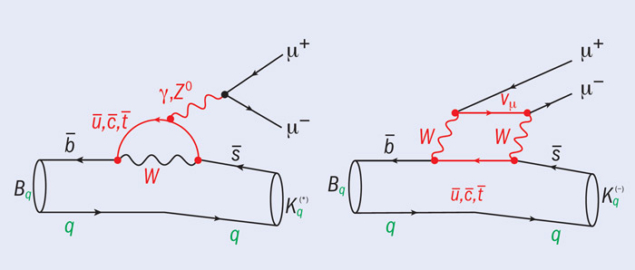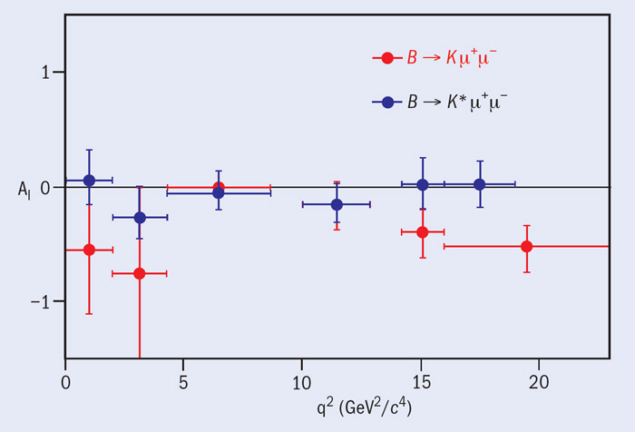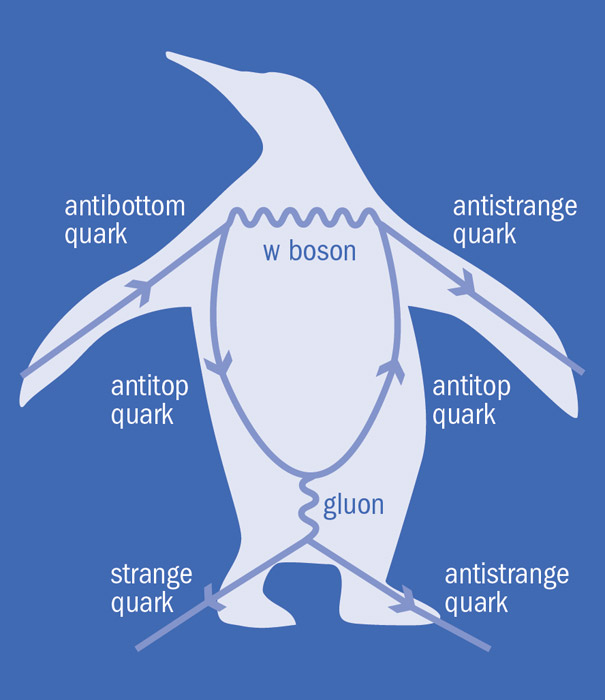The search for heavy particles beyond the direct reach of the LHC.

The recent identification of the new particle discovered at the LHC as a Higgs boson with a mass of 125 GeV/c2 completes the picture of particles and forces described by the Standard Model. However, it does not mark the end of the story as, unfortunately, the Standard Model is an incomplete description of nature. Puzzles still remain, for example, in explaining the existence of dark matter and the matter–antimatter asymmetry. The answers to these puzzles may lie in the existence of as yet undiscovered particles that would have played a key role in the early, high-energy, phase of the universe and whose existence would help to complete the description of nature in particle physics. The question then is: at what energy scale would these new particles appear?
Particle physics provides no certain knowledge about this scale but the hope is that the new particles might be produced directly in the high-energy proton–proton collisions of the LHC. However, new particles could also be observed indirectly through the effects of their participation as virtual particles in rare decay processes. By studying such processes, experiments can probe mass scales that are much higher than those accessible directly through the energy available at the LHC. This is because quantum mechanics and Heisenberg’s uncertainty principle allow virtual particles to have masses that are not constrained by the energy of the system. Searches based on virtual particles are limited by the precision of the measurements, rather than the energy of the collider.
Rare potential
One promising place to look for contributions from new virtual particles is in the rare transitions of b quarks to s quarks in which a muon pair (dimuon) is produced: b → sμ+μ–. Described by the Feynman diagrams shown in figure 1 (overleaf), these involve what are known as “flavour-changing neutral currents” because the initial quark changes flavour without changing charge. In the Standard Model, transitions of this type are forbidden at the lowest perturbative order – that is, at “tree-level”, where the diagrams have only two vertices. Instead, they are mediated as shown in figure 1 by higher-order diagrams known as “electroweak penguin” and “box” diagrams. For this reason the Standard Model process is rare, which enhances the potential to discover new high-mass particles.

Studies of flavour-changing neutral currents have paved the way for discoveries in particle physics in the past, specifically in the decays of K mesons, where s quarks change to d quarks. Investigations of mixing between the mass eigenstates of the neutral kaon system and of rare K-meson decays led to the prediction of the existence of a second u-like quark (the charm quark, c), at a time when only three quarks were known (u, d and s). It was 10 years before the existence of the c quark was confirmed directly. Similarly, the observation of CP violation in neutral kaons led to the prediction of the third generation of quarks (b and t). Now, the study of flavour-changing neutral-current processes related to the third generation of quarks – in particular the rare b → sμ+μ– transitions – could soon provide similar evidence for the existence of new particles.
The LHCb detector is characterized by excellent vertex and momentum resolution.
Several b → sμ+μ– transitions have already been observed by the Belle, BaBar and CDF experiments at KEK, SLAC and Fermilab respectively. So far, the results have been limited by the small size of the data sets but with the LHC, a new era of precision has begun. The collider is the world’s largest “factory” for producing particles that contain b quarks: in one year, it produced about 1012 b hadrons in the LHCb experiment, while running at a centre-of-mass energy of 7 TeV with an instantaneous luminosity in the experiment of 4 × 1032 cm–2 s–1. ATLAS and CMS have also recently joined the game, showing their first results on the B0 → K*0 μ+μ– decay at the BEAUTY 2013 conference (ATLAS collaboration 2013 and CMS collaboration 2013).
The LHCb detector is characterized by excellent vertex and momentum resolution (coming from its tracking systems) and impressive particle-identification capabilities (from its two ring-imaging Cherenkov detectors). Combined with the large b-hadron production rate, these features allow LHCb to reconstruct clean signals of rare b-hadron decays (figure 2). These processes have branching fractions below 10–6 and at most occur once in every 100 million collisions.
The branching fractions of these decays are sensitive to new physics but their interpretation is unfortunately complicated. The b quark has hadronized, so the observations relate to hadronic rather than quark-level processes. A lack of detailed understanding of the hadronic system limits the usefulness of the branching-fraction measurements in the search for new physics.
Angles and asymmetries
Fortunately, the branching fractions of these decays are not the only handles for investigating new particle contributions. It is often much more instructive to look at the angular distribution of the particles coming from the decay. However, such angular analyses are experimentally challenging because they require a detailed understanding of how both the geometry of the detector and the reconstruction of the event bias the angular distribution of the particles.

The decays B0 → K*0μ+μ– and Bs → φμ+μ– have been shown to be highly sensitive to a variety of new physics scenarios (LHCb collaboration 2013a and 2013b). These decays are characterized by three angles: θK, which describes the K* or φ decay; θl, which describes the dimuon decay; and Φ, the angle between the K* or φ and the dimuon decay planes.
The angular distribution of the particles depends on the properties of the underlying theory. For instance, two features of the Standard Model drive the angular distribution: the photon exchanged in the penguin diagram of figure 1 is transversely polarized, while the charged-current interaction (the W exchange) is purely left-handed. The angle in the dimuon system also has an intrinsic forward–backward asymmetry that arises from interference between the different diagrams. The forward–backward asymmetry can be studied as a function of the mass of the dimuon system, which can be anywhere between twice the muon’s mass and the difference between the mass of the B and the mass of the K* or φ.
In the Standard Model, the forward–backward asymmetry has a characteristic behaviour, changing sign at a dimuon mass of around 2 GeV/c2. It turns out that this point can be predicted with only a small theoretical uncertainty. Figure 3 shows LHCb’s measurement of the forward–backward asymmetry in the decay B0 → K*0μ+μ– . In addition, the angle Φ can be used to test nature’s left-handedness, through an observable called AT(2).
It is important to emphasize that the room for new physics is still large given the statistical uncertainty of the present measurements.
So far, measurements of both the forward–backward asymmetry and AT(2) show good agreement with the predictions of the Standard Model. While there is no evidence for any disagreement, it is nevertheless important to emphasize that the room for new physics is still large given the statistical uncertainty of the present measurements.
Another way to decrease the theoretical uncertainty associated with the hadronic transitions is to form asymmetries between specific decay modes – for example, CP asymmetries between particle and antiparticle decays. In the Standard Model, the decay B0 → K*0μ+μ– and its CP conjugate are expected to have the same branching fraction to about 1 part in 1000. With the large LHC data samples, LHCb has verified this at the level of 4% (LHCb collaboration 2013e).
Another example concerns so-called isospin asymmetries between decays that differ only in the type of spectator quark (u or d), labelled q in figure 1. The isospin asymmetry between B0 and B+ decays is defined as:
![]()
This is formed using the branching fractions of the B0 and B+ decays and the ratio τ0/τ+ of the lifetimes of the B0 and the B+. In the Standard Model, the spectator quark is expected to play only a limited role in the dynamics of the system, so isospin asymmetries are predicted to be tiny. Experimentally, AI is measured as a double ratio with respect to the decay channels B0 → K(*)0 J/ψ or B+ → K(*)+ J/ψ, which give the same final states after the J/ψ decays to μ+μ– and are well known from previous measurements.

Isospin asymmetries have been measured for both B → K*μ+μ– and B → Kμ+μ– by the BaBar, Belle, CDF and LHCb experiments. All of these measurements are in good agreement with each other and favour a value for AI(B → K* μ+μ–) that is close to zero and a negative value for AI(B → Kμ+μ–). The LHCb experiment observes a negative isospin asymmetry in this channel at the level of four standard deviations (from zero) as figure 4 shows (LHCb collaboration 2012). This unexpected result is yet to be explained. Indeed, most extensions of the Standard Model do not predict a significant dependence on the charge or flavour of the spectator quark.
Looking to the future
The LHCb experiment has already on tape a data set that is roughly three times larger than that used in its results published so far. Even with only 1 fb–1 of integrated luminosity currently analysed, LHCb has larger samples than all previous experiments combined in most of the channels shown in figure 2. Furthermore, while the selected current data sets contain hundreds of events, the samples will be of the order of tens of thousands of events once the experiment has been upgraded. With these larger data sets the LHCb collaboration will be able to chase progressively smaller and smaller deviations from the Standard Model. This will allow them to probe ever higher mass scales, far beyond those that can be accessed by searching directly for the production of new particles at the LHC. A new era in precision measurements of flavour-changing neutral currents is now opening.
John Ellis on the origin of penguins

“Mary K [Gaillard], Dimitri [Nanopoulos], and I first got interested in what are now called penguin diagrams while we were studying CP violation in the Standard Model in 1976 … The penguin name came in 1977, as follows.
In the spring of 1977, Mike Chanowitz, Mary K and I wrote a paper on GUTs [grand unified theories] predicting the b quark mass before it was found. When it was found a few weeks later, Mary K, Dimitri, Serge Rudaz and I immediately started working on its phenomenology.
That summer, there was a student at CERN, Melissa Franklin, who is now an experimentalist at Harvard. One evening, she, I and Serge went to a pub, and she and I started a game of darts. We made a bet that if I lost I had to put the word penguin into my next paper. She actually left the darts game before the end, and was replaced by Serge, who beat me. Nevertheless, I felt obligated to carry out the conditions of the bet.
For some time, it was not clear to me how to get the word into this b-quark paper that we were writing at the time … Later … I had a sudden flash that the famous diagrams look like penguins. So we put the name into our paper, and the rest, as they say, is history.”
John Ellis in Mikhail Shifman’s “ITEP Lectures in Particle Physics and Field Theory”, hep-ph/9510397. Reproduced here courtesy of symmetry magazine.








1 Comment